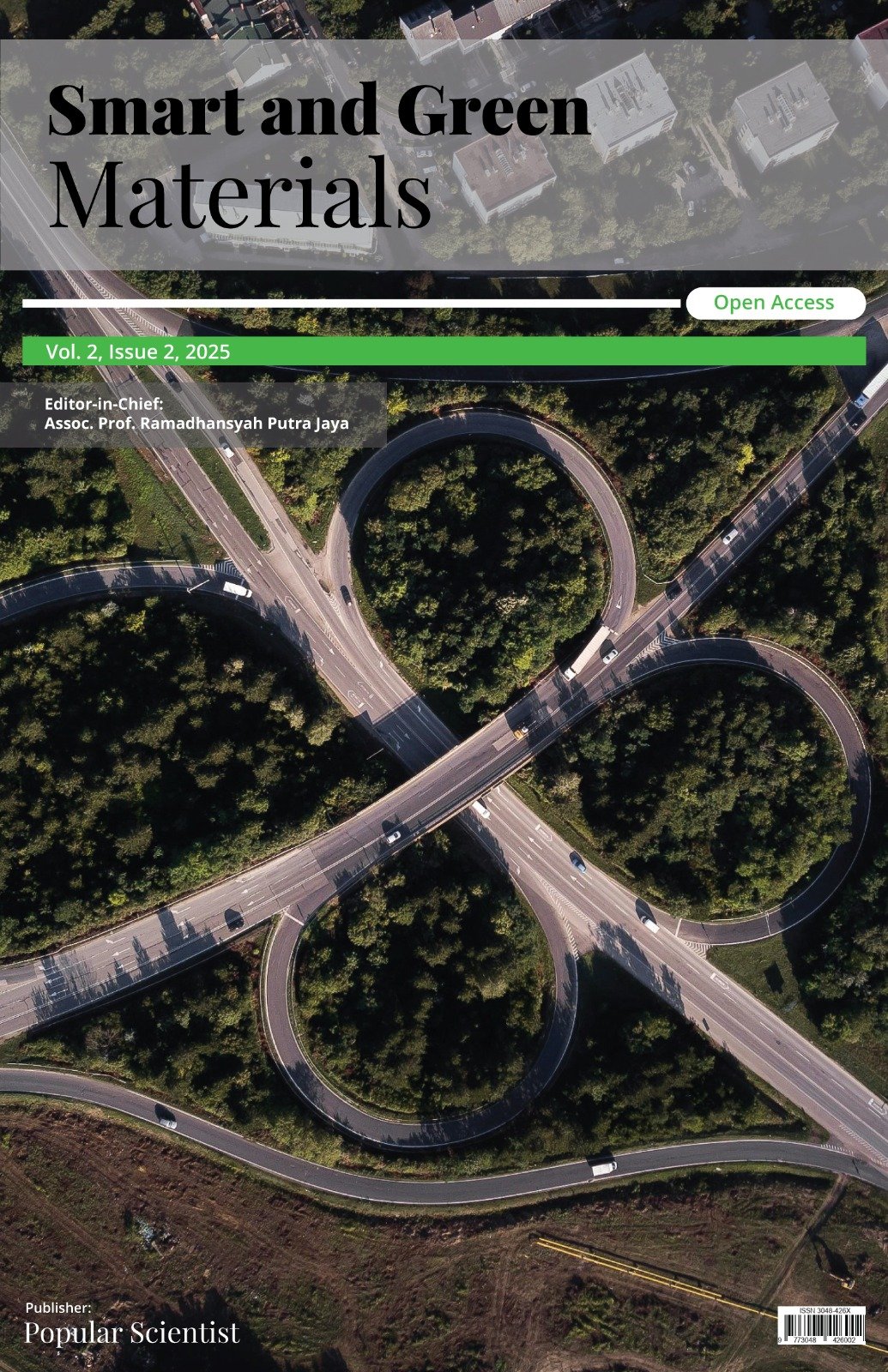Effect of Internal Curing with Super-absorbent Polymer on the Surface Hardness of Normal Strength Concrete
DOI:
https://doi.org/10.70028/sgm.v2i2.46Keywords:
Moisture content, Self-concrete curing, Super-absorbent polymer, Surface hardness, Ultra Pulse VelocityAbstract
The traditional curing methods for concrete might be difficult for reinforced concrete tall building and some dangerous parts. Thus, using internal curing methods with different agents which exposed to be a perfect method to reduce risk for labors and reduce the difficulty of curing. Even though, the internal curing has a positive impact on the mechanical properties, such as compressive and tensile strengths, the hardness of the concrete cured with internal curing agents encounter an issue due to leaving voids in concrete. This investigation highlights the influence of super absorbent polymer on the surface hardness and void content in the normal strength concrete. As a result, it was found that the surface hardness of the concrete improves up to 19% due to inclusion of 0.08% of super absorbent polymer to cement ratio. However, the velocity of passing wave through concrete via ultra-pulse velocity device was reduced due to increasing the length of path of the wave from separating voids in the concrete.
Downloads
References
S. H. Kosmatka, B. Kerkhoff, and W. C. Panarese, Design and Control of Concrete Mixtures, EB001, 14th ed. Shokie, Illinois, USA: Portland Cement Association, 2002.
ACI Committee 308, “Guide to Curing Concrete,” U.S.A2008.
ACI Committee 308, “Specification for Curing Concrete,” U.S.A2011.
J. A. Zemajtis, “Role of Concrete Curing,” America’s Cement Manufacturers2022. Cement Concrete and Aggregates Australia, “Curing of Concrete,” 2006.
D. O. Olanrewau, A. Y. Akinsaya, and Q. A. Olowu, “Effect of high curing temperature on mechanical propertties of concrete,” presented at the 2nd World Conference on Technology, Innovation and Entrepreneurship, Istanbul, Turkey, 2017
J. Fladr and I. Broukalova, “Influence of curing temperature on the mechanical properties of high-performance concrete,” presented at the International Conference Building Materials, Products and Technologies, 2019.
A. Kaleta-Jurowska and K. Jurowski, “The influence of Ambient Temperature on High Performance Concrete Properties,” MDPI-Materials, vol. 13, 2020.
I. B. Topcu and M. U. Toprak, “Fine aggregate and curing temperature effect on concrete maturity,” Cement and Concrete Research, vol. 35, pp. 758-762, 2004.
ACI 308R, “Guide to External Curing of Concrete,” Farmington Hills, MI 483312016.
W. Z. Taffese, “Data-driven method for enhanced corrosion assessment of reinforced concrete structures,” Ph.D, University of Turku, Turku, Finland, 2020.
M. Amran, A. M. Onaizi, R. Fediuk, N. I. Vatin, R. S. M. Rashid, H. Abdelgader, et al., “SelfHealing Concrete as a Prospective Construction Material: A Review,” materials: MDPI, vol. 15, 2022.
D. A. Triana-Camacho, J. H. Quintero-Orozco, E. Mejia-Ospino, G. Castillo-Lopez, and E. Garacia-Macias, “Piezoelectic composite cements: Towards the development of selfpowered and self-diagnostic materials,” Cement and Concrete Composites, vol. 1, 2023.
K. W. Shah and G. F. Huseien, “Biomimetic Self-Healing Cementitious Construction Materials for Smart Buildings,” biomimetics, MDPI, vol. 5, 2020.
C. Chen, S. Chen, Y. Zhenyao, X. Shi, and T. Ma, “The effect of Alchohol consumption on Brain Ageing: A new causal inference framework for incomplete and massive phenomic data,” 2024.
N. Tran, N. Tuan, J. R. Black, and N. Tuan, “High-temperature Stability of Ambient-cured One-part Alkali-activated Materials Incorporating Graphene for Thermal Energy Storage,” 2024.
M. Raghav, T. Park, H. Yang, S. Lee, S. Karthick, and H. Lee, “Review of the Effects of Supplementary Cementitious Materials and Chemical Additives on the Physical, Mechanical and Durability Properties of Hydraulic Concrete,” materials: MDPI, vol. 14, 2021.
F. J. Vazquez-Rodriguez, N. Elizondo-Villareal, L. H. Verastegui, A. M. A. Tovar, J. F. LopezPerales, J. E. C. de Leon, et al., “Effect of Mineral Aggregates and Chemical Admixtures as Internal Curing Agents on the Mechanical Properties and Durability of High-Performance Concrete,” materials: MDPI, vol. 13, 2020.
M. H. B. Souza, B. A. Teixeira, P. C. Goncalves, L. R. R. Silva, M. L. N. M. Melo, V. A. S. Ribeiro, et al., “Effects on the propeties of Self-Compacting Cement Paste (PAA) with the Addition of Superabsorbent Polymer,” materials: MDPI, vol. 15, 2022.
S. Gupta, K. Harn-wei, and P. Sze-dai, “Autonomous Repair in Cementitious Material by Combination of Superabsorbent Polymers and Polypropylene Fibres: A Step Towards Sustainable Infrastructure,” presented at the World Sustainable Built Environment Conference - Track 12:Emerging Green Construction Technology and Materials Hong Kong, 2017.
ASTM C150-22, “Standard specification for portland cement,” vol. C01.10, ed, 2022.
ASTM C805-13a, “Standard test method for rebound number of hardened concrete,” ed, 2013.
BS EN 12504-4, “Testing Concrete-Part 4: Determination of ultrasonic pulse velocity,” vol. BS EN 12504-4, ed, 2004.
BS 1881-203, “Testing Concrete Part 203: Recommendations for measurement of velocity of ultrasonic pulses in concrete,” ed, 1986.
BS EN 12390-3, “Testing hardened concrete,” in Part3: Compressive strength of test specimens, ed. London, 2009, p. 16.
BS EN 12390-7, “Testing hardened concrete: part 7: density of hardened concrete,” ed. Brussels, 2019.
A. S. Ali and F. R. Karim, “Influence of internal curing on the properties of non-fibrous high strength concrete-A critical review,” Journal of Cement Based Composites, vol. 3, pp. 1-6, 2020.
F. R. Karim, “Influence of Internal Curing with Lightweight Pumice Fine Aggregate on the Mechanical Properties of Cement Mortars,” Construction, vol. 2, pp. 104-113, 2022.
F. R. Karim, A detailed study of Building Material Tests vol. 1. Sulaimani, Iraq, 2022.
F. R. Karim, “Behaviour of Under-reinforced Shallow Fibrous Concrete Beams Subjected to Pure Torsion,” Ph.D., Civil Engineering Department, University Sains Malaysia, Penang, Malaysia, 2016
Downloads
Published
Issue
Section
License
Copyright (c) 2025 Ferhad Karim (Author)

This work is licensed under a Creative Commons Attribution-NonCommercial 4.0 International License.













